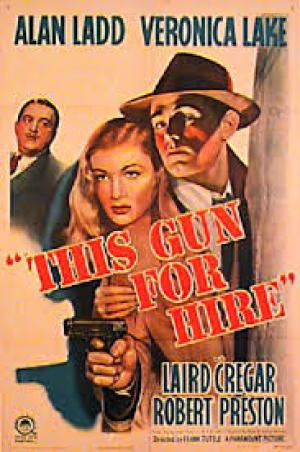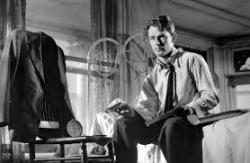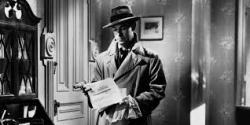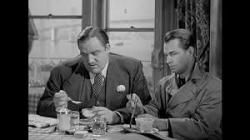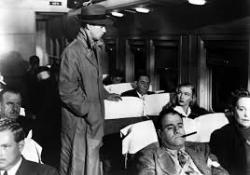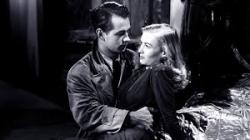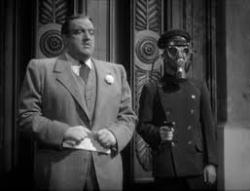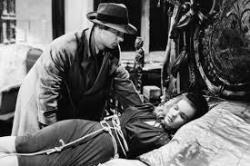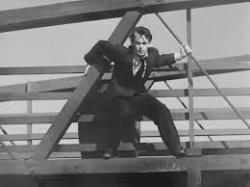New Review Page
By Michael J. Roberts
“I just want to make pictures that are entertaining. I'll leave the scenery chewing to someone else.” ~ Alan Ladd
This Gun For Hire is one of several crime thrillers that bridge the gap between the pre-war Warner Bros led Gangster flicks and the lauded Film Noir period that emerged after the war. In 1942 Paramount handed journeyman director Frank Tuttle a job of work with a Graeme Greene novel as source material and a script by newcomer Albert Maltz and W.R. Burnett, the script writer of Little Caesar and Scarface. Contracted Paramount actors Veronica Lake and Robert Preston were cast as the nominal stars, but the film was stolen from them by a little known actor who had been languishing in bit parts for years at the studio, but after this star making part he languished no more – his name was Alan Ladd.
Philip Raven (Alan Ladd) is a cold-eyed hitman employed by Willard Gates (Laird Cregar) to recover some documents and eliminate the person who possessed them. Things go wrong when, after a successful hit, Gates double crosses Raven by paying him in marked bills. Raven sets about getting revenge but in the process gets mixed up with a nightclub singer who is employed by Gates and things get complicated. The singer, Ellen Graham (Veronica Lake) has a boyfriend cop (Robert Preston) looking out for her and soon all the threads come together when Raven kidnaps Ellen as he relentlessly pursue vengeance on Gates. The McGuffin subplot involves the documents being a formula Gates is trying to sell to wartime enemies and Ellen doing her patriotic bit to beat the spies.
Alan Ladd dominated the screen, so much so that Paramount quickly started producing posters where the 4th ranked billing became the prominent player, alongside Veronica Lake. The chemistry between the two far outshone that of Lake and Preston, a typically cardboard cut-out good guy who is always a step behind the action. Ladd’s Raven predated Richard Widmark’s proto moderne Kiss of Death psycho, Tommy Udo, by some 5 years, albeit with a more balanced depiction of a tough guy aided by a nicely drawn character that made plain the notion that Raven’s problems were likely foisted upon him by a cruel father. Ellen’s character sees the human being under the psychological pain and that adds a degree of understanding and tenderness rare for a Hollywood film of the time, and led to a film that had more in common in tone with some French or UK dramas of the era, possibly because of the Greene source material.
This Gun For Hire is a classic example of the sum of the whole being greater than the sum of the parts. This may well be Exhibit A for the promoting the success of the Hollywood production line model – given that Tuttle was no auteur by any stretch and that no superstar names appeared above the title. The film is a prime example of experienced technicians doing a superior job of work and producing an outstanding result in the doing. Tuttle had been directing for 20 years without any notable acclaim and cinematographer John Seitz was a 25 year veteran at the time of shooting – he had been nominated for an Academy Award in 1930 and was about to hit his prime in the Noir genre working on Wilder's Double Indemnity and The Lost Weekend, as well as on John Farrow’s The Big Clock. The source material was strong and was beautifully adapted by Burnett, who had been involved scripting the hard-boiled Little Caesar, Scarface and more recently his own novel High Sierra. Albert Maltz was to become notorious later in the decade as one of the Hollywood Ten and was never overly fond of the film.
Maltz may well have overlooked the left-leaning strengths of the film in terms of demonising big business (the villain is the corporate boss capable of betraying his country for money) and on the society that created Raven, springing from an abusive childhood and probable poverty. What is remarkable is how little moral judgement there is as to his line of work from the sympathetic female character. Business, in the form of Gates, employs Raven to do some work, then stiffs him on his agreed payment – they are equally morally bankrupt and murder is just the cost of doing business in both their worlds. Either way Raven’s actions are mitigated somewhat by a psychological backstory and by his sentimental side with cats and children – this gives Ellen a way to humanise Raven and appeal to his better side. This is rare nuance for a film of the time where scenarios tended to be (literally) black and white.
Frank Tuttle was able to frame the lead performances perfectly, and Alan Ladd certainly never forgot his debt, repeatedly employing Tuttle in later years when he had both the clout and the chance. Veronica Lake is very fine as the smart girl trying to do the right thing for her country, and Cregar is wonderful as the corpulent villain. Robert Preston is limited by the role and his natural staginess, but it’s Alan Ladd’s film from start to finish and he makes every post a winner. Ladd was never a versatile star, but he had a strong screen presence and a sense of stillness and strength that belied his smaller than average stature. He was certainly suited to Noir type tough guys, but it was his ability to play any role sympathetically that made him a star – and none more so than his brilliant performance as the taciturn gunman in George Stevens’ Shane in 1953.
Frank Tuttle is something on an enigma in the modern world, part the invisible man and part the forgotten man, but at least with this film he achieved greatness. He began his directing career at Paramount in 1922 and worked consistently for two decades before This Gun For Hire came along and never again produced a film to match it before he retired in 1959. John Seitz proved how adept he was at the Noir filmic language and produced a visual gem that stills ranks amongst the great Noir achievements in cinematography, it was enough of a clue for Billy Wilder to snap him up for Double Indemnity et al.
Veronica Lake had a rocky road in Hollywood and never really broke out of her typecast roles - the pretty girl in trouble and dependent on the hero. She appeared in a variety of films of varying quality for another decade before her reputation for being difficult, alcoholism and a disinterest in the star system led her to an early death at the age of 50. This would be old age in comparison to the ill-starred Laird Cregar, who was 25 when This Gun For Hire was made and died only a couple of years later at 27. That’s showbiz.
